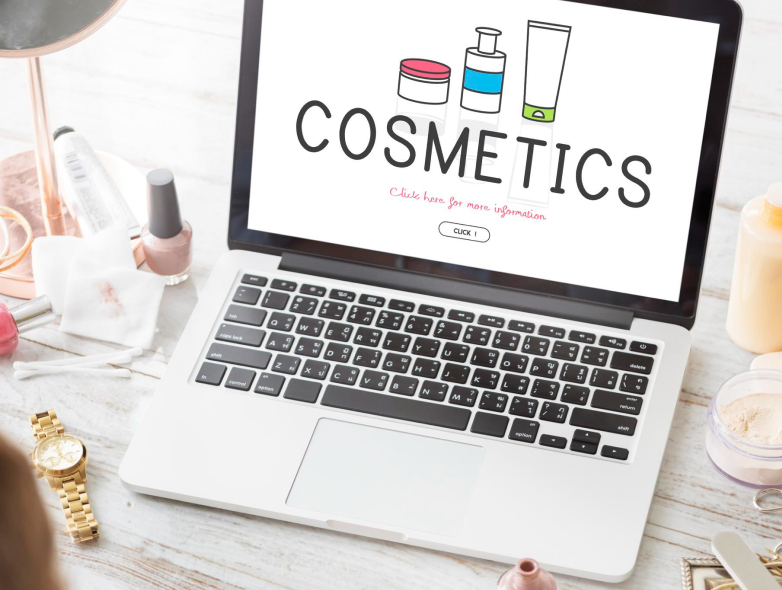Create a Cosmetics E-Commerce Website – Step-by-Step Guide
The cosmetics e-commerce industry is growing fast, driven by digital trends and changing consumer behavior. NIQ reported in March 2024 that US households with tweens contribute 49% of mass skincare growth, marking a key shift in the market. Online beauty shopping thrives on convenience, AI-driven recommendations, and virtual try-ons.
Top e-commerce sites succeed by offering seamless user experiences that keep shoppers engaged. This guide will walk you through 10 essential steps to build a high-converting cosmetics e-commerce website.
Why a High-Converting E-Commerce Website is Key for Cosmetics Brands
The beauty industry has moved beyond traditional retail, with more consumers shopping for cosmetics online. Whether you're launching a makeup brand, skincare line, or luxury beauty products, a highly optimized e-commerce website is essential for success. The right e-commerce website builder can significantly impact your sales.
However, not just any website will do—you need a conversion-focused e-commerce store that attracts traffic, engages visitors, and turns them into loyal customers.
How to create a cosmetics e-commerce website?
To create a cosmetics e-commerce website, choose a reliable e-commerce platform, design a user-friendly store, and optimize it for conversions. Focus on branding, SEO, and seamless shopping experiences to attract and retain customers.
Step 1: Choose the Right Niche and Define Your Brand Identity
Before you create an e-commerce website, identifying your niche and building a strong brand identity is crucial. Choose trending beauty products, analyze competitors, and ensure uniqueness. Selecting the best e-commerce website builder helps establish a professional, user-friendly store, making it the best website for online store.
How to Choose the Right Niche:
-
● Identify high-demand beauty products (organic skincare, cruelty-free cosmetics, luxury makeup).
-
● Research customer pain points and offer solutions (e.g., vegan lipsticks for sensitive skin).
-
● Analyze trends using Google Trends, Instagram, and YouTube beauty influencers.
Optimizing Your Brand Identity for SEO:
-
● Choose a brand name and domain that reflects your niche (e.g., GlowNaturals.com).
-
● Use keywords like best website for online store and top 10 e-commerce websites in your meta description.
Step 2: Select the Best E-Commerce Website Builder Identity
Choosing the right e-commerce platform can make or break your success. The best website builder for an online store should be user-friendly, scalable, and optimized for mobile. It must offer seamless navigation, fast load times, and secure payment options. Look for built-in SEO tools, customizable templates, and integrations with marketing tools to enhance visibility. The best website for online stores should also support multi-channel selling, allowing you to reach customers across social media, marketplaces, and search engines.
Best E-Commerce Website Builder for Success:
-
● Easy to Use – No coding required, with drag-and-drop features for a hassle-free setup.
-
● SEO-Friendly – Custom URLs, meta tags, and sitemaps improve search rankings and visibility.
-
● Mobile-Responsive – A mobile-friendly design ensures smooth browsing, as most beauty shoppers use smartphones.
Top E-Commerce Website Builders:
-
● Shopify – Best for beginners and managing large product catalogs efficiently.
-
● WooCommerce – Ideal for WordPress users seeking customization and flexibility.
-
● BigCommerce – Great for scalable growth with built-in SEO optimization tools.
Optimizing Your Website for Performance:
-
● Use lightweight themes – Faster loading speeds enhance the user experience and reduce bounce rates.
-
● Optimize images – Compressed images ensure mobile-friendly performance and better site speed.
-
● Choose a secure checkout system – Offer Stripe, PayPal, or Apple Pay for smooth and safe transactions..
Step 3: Design a High-Converting and Mobile-Friendly Website
Create an e-commerce website with a seamless shopping experience across all devices. Choosing the best website builder for an online store ensures smooth navigation and high conversions. A well-designed site keeps users engaged and reduces bounce rates, making it one of the top 10 e-commerce websites.
Key Website Design Elements for Beauty E-Commerce:
-
● Clean and Minimalistic Layout – A simple design helps products stand out and enhances user experience.
-
● HD Product Images and Videos – Showcase cosmetics in different lighting to build trust and engagement.
-
● Mobile-First Design – A must-have feature to ensure easy navigation for mobile users.
How to Optimize for UX & SEO:
-
● Add Structured Data (Schema Markup) – Helps search engines display rich results for better Google visibility.
-
● Use Keywords in Alt Text & Titles – Include “best cosmetic for online store” in product images and titles for SEO.
-
● Implement a Mega Menu – Makes it easier for users to browse categories when they create e-commerce websites.
Step 4: Create Compelling Product Pages That Sell
Your product pages should do more than just display products; they should convince customers why they need them. A well-structured page highlights key benefits, builds trust, and encourages conversions. Choosing the best e-commerce website builder with cosmetic eCommerce website features ensures high-quality product pages for maximum engagement.
Key Elements of a High-Converting Product Page:
-
● Engaging Product Descriptions – Focus on features and benefits. Describe how the product enhances the customer’s beauty routine and solves common skincare or makeup concerns. Use persuasive, benefit-driven language.
-
● Social Proof for Credibility – Display reviews, testimonials, and user-generated content to build trust. Shoppers rely on peer recommendations, so showcase authentic customer feedback.
-
● SEO-Optimized Product Titles and Meta Descriptions – Well-crafted titles and meta descriptions improve search rankings. Include relevant keywords naturally while keeping the content informative and engaging.
SEO Optimization Tips for Product Pages:
-
● Use Long-Tail Keywords – Keywords like “best e-commerce website builder for beauty products” help attract customers searching for niche beauty items. Include them in product descriptions naturally.
-
● Add Bullet Points for Readability – Break down product features into short, clear bullet points. This improves user experience and makes it easier for customers to scan and compare products.
-
● Optimize Product Images – Use high-resolution images with descriptive alt tags. Compress images to ensure fast page load speed without sacrificing quality.
Step 5: Streamline the Checkout Process to Reduce Cart Abandonment
A complicated or lengthy checkout process is one of the biggest reasons customers abandon their carts before completing a purchase. Even if your products and website are well-optimized, a frustrating checkout experience can lead to lost sales. When you create an e-commerce website, ensuring a smooth payment experience should be a top priority.
How to Optimize Your Checkout Process:
-
● Offer One-Click Checkout with Saved Payment Details – Simplify the process by allowing customers to save their payment information for future purchases. This reduces friction and speeds up the transaction.
-
● Enable Guest Checkout – Forcing users to create an account before purchasing can significantly lower conversions. Offer a guest checkout option to make the process quicker and more user-friendly.
-
● Display Secure Payment Badges – Customers need reassurance that their payment details are safe. Featuring trust signals like SSL certificates, secure payment provider logos (PayPal, Stripe, Apple Pay), and encrypted checkout icons can build confidence and encourage transactions.
-
● Minimize Form Fields and Steps – Only ask for essential information. Long and unnecessary forms can frustrate users, leading to abandoned carts. Use auto-fill options for faster data entry.
-
● Provide Multiple Payment Methods – Offering various payment options, such as credit/debit cards, digital wallets, and Buy Now, Pay Later services, caters to a broader audience and increases conversions.
-
● Show a Transparent Pricing Summary – Clearly display product costs, taxes, shipping fees, and discounts before the final purchase step. Unexpected charges at checkout can lead to last-minute drop-offs.
SEO Optimization for Checkout Pages:
-
● Use Keywords in Meta Titles and Descriptions – Include phrases like “create e-commerce website” in your checkout page’s meta title and description to improve search rankings. This helps potential customers find your site when searching for streamlined online shopping experiences.
-
● Optimize for Fast Page Speed – A slow-loading checkout page can frustrate users and increase abandonment rates. Google also ranks faster pages higher in search results. Reduce page load times by compressing images, using lightweight code, and enabling caching.
-
● Ensure Mobile-Friendly Checkout – Many beauty shoppers use smartphones to make purchases. A mobile-optimized checkout with easy navigation, larger buttons, and autofill options enhances the experience and reduces cart abandonment.
Step 6: Implement SEO Strategies for Long-Term Growth
SEO is the backbone of any successful cosmetics e-commerce website. Without proper optimization, even the most beautifully designed store will struggle to attract organic traffic. By implementing strategic SEO techniques, you can improve your site's visibility on search engines, drive targeted traffic, and increase conversions over time. Whether you are using the best website for online store or building your e-commerce site from scratch, SEO should be an ongoing priority.
Essential SEO Strategies for E-Commerce Growth
Keyword Research for Beauty-Specific Search Terms – Conduct in-depth keyword research to find high-intent beauty-related search queries. Use tools like Google Keyword Planner, Ahrefs, or SEMrush to identify relevant long-tail keywords such as “best website for online store” or “top organic skincare brands.” Integrate these keywords naturally into your product descriptions, blogs, and meta tags.
On-Page SEO Optimization – Optimize your content by structuring pages with H1, H2, and H3 tags that include relevant keywords. For example, a product category page for skincare can have:
-
● H1: Best Skincare Products for Radiant Skin
-
● H2: How to Choose the Right Moisturizer for Your Skin Type
-
● H3: Ingredients to Look for in a Hydrating Serum
Technical SEO for a Seamless User Experience – Search engines favor websites that are technically sound. Regularly audit your website to fix broken links, create SEO-friendly URLs, and generate an XML sitemap for better indexing. Optimize for mobile users, as most beauty shoppers browse on their smartphones.
Page Speed Optimization – Slow-loading websites lead to higher bounce rates. Compress images, use a content delivery network (CDN), and enable lazy loading to improve site speed. Google rewards fast websites with better rankings, ensuring your store stays competitive.
Voice Search Optimization – Many consumers use voice search to find products. Optimize content with conversational keywords like “Which is the best website for online store for beauty products?” to capture this growing audience.
Best SEO Practices for E-Commerce Websites
Use SEO-Friendly URLs – URLs should be short, descriptive, and keyword-rich.
Instead of a generic product page like /p12345,
use an SEO-friendly format like /best-matte-lipstick-collection.
This improves search engine rankings and makes URLs more user-friendly.
Implement Internal Linking to Increase Engagement – Link relevant product pages and blog posts within your website. For example, a lipstick product page can link to a blog post about “How to Choose the Perfect Lipstick Shade.” Internal links keep users on your site longer and improve search engine indexing.
Optimize Meta Tags with Strategic Keywords – Your meta titles and descriptions should include primary keywords to improve search visibility. A well-optimized title could be:
-
● Top 10 E-Commerce Websites for Beauty Products – Shop Now
Leverage Schema Markup for Rich Snippets – Use structured data to enhance search results with rich snippets, including product prices, ratings, and availability. This makes your listings more attractive to potential customers.
Step 7: Leverage Social Media & Influencer Marketing
Social proof plays a crucial role in the beauty industry, where customers rely on recommendations, reviews, and visual content before making a purchase. Leveraging social media and influencer marketing can significantly boost your brand’s reach, engagement, and sales. The best e-commerce website builder should seamlessly integrate with social media platforms to maximize visibility.
How to Boost Sales Through Social Media
-
● Partner with Beauty Influencers on TikTok & Instagram – Collaborate with beauty influencers who align with your brand. Influencers create authentic content, showcasing your products to a highly engaged audience. Consider micro-influencers for cost-effective partnerships with high conversion rates.
-
● Create Shoppable Posts & Reels to Drive Direct Traffic – Platforms like Instagram and Facebook allow you to create shoppable posts where users can buy directly without leaving the app. Use engaging Reels and video tutorials to demonstrate product benefits, increasing impulse purchases.
-
● Run Facebook & Instagram Ads Targeting Beauty Enthusiasts – Social media ads help reach your target audience faster for your cosmetic eCommerce website. Use precise targeting options like age, gender, interests, and purchase behavior to attract potential buyers. Retarget website visitors with dynamic product ads to bring them back to your store and boost sales.
SEO Optimization Tip
-
● Optimize your social media profiles by including relevant keywords like "best e-commerce website builder" in your bio, captions, and hashtags. Ensure your website is linked on all platforms for seamless shopping.
Step 8: Launch an Effective Email Marketing Strategy
Email marketing remains one of the most profitable digital marketing strategies, with a high return on investment (ROI). A best website for an online store should have built-in email marketing integrations for automation.
How to Use Email for More Sales
-
● Send Exclusive Discounts & Personalized Product Recommendations – Segment your email list based on customer preferences and shopping behavior. Send personalized product suggestions, special offers, and early access to new launches to boost conversions.
-
● Use Abandoned Cart Emails to Recover Lost Sales – Nearly 70% of shoppers abandon their carts. Set up automated emails reminding them to complete their purchase, offering incentives like free shipping or limited-time discounts.
-
● Offer a Loyalty Program to Reward Repeat Customers – Encourage customer retention with loyalty programs. Reward points for purchases, reviews, and referrals, redeemable for discounts on future buys.
SEO Tip
Create engaging blog content using keywords like "create e-commerce website" to grow your email list. Offer a free beauty guide, skincare tips, or a discount in exchange for newsletter sign-ups.
Step 9: Optimize Your Website for Speed and Performance
Website speed directly impacts user experience, SEO rankings, and conversion rates. A slow-loading site frustrates visitors, leading to higher bounce rates and lost sales. The best e-commerce website builder should include performance optimization features to enhance speed.
How to Improve Website Speed
-
● Use CDNs (Content Delivery Networks) Like Cloudflare – CDNs store copies of your website on multiple servers worldwide, ensuring faster loading times regardless of user location.
-
● Implement Lazy Loading and Image Compression – Large, unoptimized images slow down pages. Use image compression tools and lazy loading (loading images only when needed) to improve speed.
-
● Optimize Code and Remove Unnecessary Scripts – Minimize JavaScript, CSS, and third-party plugins that slow down site performance. Ensure your website theme is lightweight and optimized for speed.
-
● Enable Browser Caching for Faster Load Times – Browser caching stores website data locally, reducing load times when users revisit your site.
SEO Benefit
Google prioritizes fast-loading websites in search rankings. Optimizing speed helps you rank higher, improving visibility and sales.
Step 10: Track & Optimize with Analytics
Data-driven decisions are key to e-commerce success. Monitoring website performance through analytics helps identify strengths, weaknesses, and opportunities for improvement. Whether using Shopify, WooCommerce, or another best website for online store, ensure you have built-in analytics tools.
How to Use Analytics to Improve Performance
-
● Track Bounce Rates & Conversion Rates in Google Analytics – A high bounce rate indicates poor user experience. Analyze which pages have the highest drop-off rates and optimize them with better content and visuals.
-
● Use A/B Testing to Optimize Product Pages – Test different product images, descriptions, CTAs, and pricing strategies to determine what resonates best with customers. Use the insights to improve conversions.
-
● Monitor SEO Performance and Update Content Regularly – Keep track of keyword rankings, organic traffic, and backlinks. Update outdated content and add fresh blogs targeting keywords like "top 10 e-commerce websites" to stay relevant.
Conclusion
Building a successful cosmetics e-commerce website requires a strategic approach from selecting the best platform to optimizing for SEO and marketing. At Clickbox, we are the best e-commerce service provider, offering end-to-end solutions to help you build a high-converting online beauty store. Our seamless SEO services ensure maximum visibility and long-term growth.
Ready to take your beauty brand to the next level? Check now! If you have any doubts, feel free to contact us today!
John Click
Digital Marketer | SEO Copywriter | Content Strategist
Experienced digital marketer with a proven track record in creating compelling content that not only engages audiences but also drives conversions and enhances SEO visibility. My expertise extends beyond marketing strategy to crafting persuasive narratives that resonate with your target audience. I combine data-driven strategies with captivating writing to deliver measurable results, ensuring your brand shines in the digital landscape.
John Click
Digital Marketer | SEO Copywriter | Content Strategist
Experienced digital marketer with a proven track record in creating compelling content that not only engages audiences but also drives conversions and enhances SEO visibility. My expertise extends beyond marketing strategy to crafting persuasive narratives that resonate with your target audience. I combine data-driven strategies with captivating writing to deliver measurable results, ensuring your brand shines in the digital landscape.






 Digital Marketing
Digital Marketing


 Digital Marketing
Digital Marketing Digital Marketing
Digital Marketing



